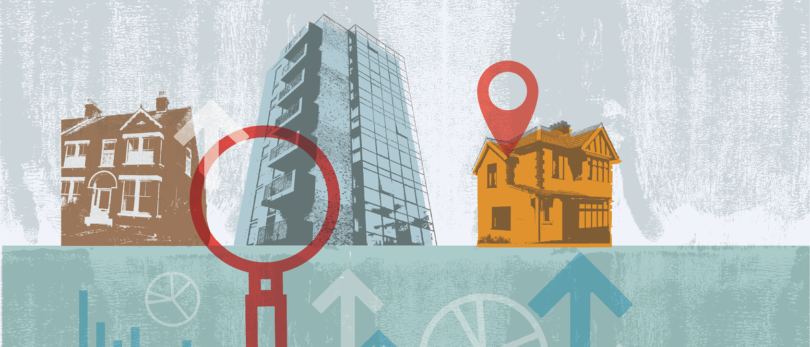Automated valuation models (AVMs) can help agents showcase their market knowledge and pricing expertise for homebuyers and sellers
By Michelle Huffman
Since the debut of the controversial Zestimate, online home value estimates have become an immutable part of the listing conversation.
But the best real estate agents have embraced the ubiquity of automated valuation models (AVMs)—and use their estimates to show clients the value they bring to appropriately pricing and selling a home.
“These estimates don’t intimidate me—they can even be mildly helpful,” says Scott Lewis, CRS, broker with the Scott Lewis Group at John L. Scott Real Estate in Ashland, Oregon. “But truly evaluating a home and determining its real market value requires a human touch because it’s a human who’s purchasing the home.”
AVMs estimate a home’s value with a trove of data, typically comparable home sales, home features (age, square footage, bedrooms, bathrooms), public records (tax assessments, prior sales) and market trends.
“When AVMs first became public, they were viewed as gospel by everyone,” says Carl Medford, CRS, sales agent at Keller Williams Advisors in Fremont, California. “Now that time has passed, and the real estate community as a whole has been debunking this literally for years, we are seeing fewer clients thinking these are accurate.”
So, instead of shying away from AVM estimates, many CRSs lean into them and explain how they work, show where they are typically accurate and where they aren’t, point out their limitations and use them to provide sellers with insight into how they create a listing strategy that actually sells houses. Here’s how agents can use AVMs to their advantage.
1. Provide estimates upfront.
Most CRSs assume their clients are already familiar with these numbers, so they come prepared to discuss what’s on sites like Zillow, Trulia, Realtor.com, Homes.com and Redfin. The presentation of these figures is itself a clue to their limited accuracy—they often represent a wide range of price points, particularly for homes that haven’t seen the market for some time. A home near Medford that has been off-market for years had estimates ranging from $1.155 million to $1.532 million—a variance of nearly $400,000.
2. Point out the limitations.
“All that any of the websites can typically see of any property is the roof,” Medford says. “They have no way of accessing the current interior to see any upgrades or property condition.”
This blind spot may or may not work in the sellers’ favor, depending on what they’ve done to their property during their tenure as homeowners, but pointing out this missing information is a good way to get sellers on board with your valuation—which includes actually looking inside the house.
Jessica Olevsky, CRS, broker-owner at JPAR Stellar Living in Gaithersburg, Maryland, points out what’s not included as well as what is. For example, Zillow uses public property records that include refinances and home loans, where appraisals are typically more generous, she says. They also consider older comps, whose price points may already be nearly irrelevant in a changing market, Olevsky adds.
AVMs also struggle for accuracy in areas with less uniform housing stock, where true comps are hard to find.
“If you have unique properties, which is most of the world, then those numbers are just guidelines,” says Tamara O’Connor, CRS, broker-owner at Premier Living Properties in St. Charles, Illinois.
3. Detail the advantages of your analysis.
An agent’s comparative market analysis (CMA), however, looks beyond market trends and home configurations, Medford says.
“A CMA takes into account property conditions, amenities, upgrades, condition of the overall neighborhood and other specifics that an AVM cannot effectively address,” he says.
Many CRSs also look at more comps than an AVM does, including active listings, under-contract and just-sold homes, as well as homes that were listed but were withdrawn or expired.
“There’s a lot we can learn from those that did not sell,” Lewis says. “Why didn’t they sell? What was the price per square foot, location, condition, views, etc., and how do those elements compare to our property?”
Olevsky will also walk sellers through her pricing process: ”We do the math right in front of the client,” she says. This offers transparency that you just can’t get with the “black box” algorithms behind AVMs.
 4. Highlight the advantages of local knowledge.
4. Highlight the advantages of local knowledge.
Algorithms may be based on local data, but there’s no experience behind that, Lewis says.
“We all have access to the same data, but it’s our local experience that gives us a distinct advantage,” he adds.
O’Connor knew this when selling her father’s home in faraway South Carolina, so she trusted a local agent’s suggested price point over her own.
“If it were that easy to price property without having that local knowledge, I would have priced it $50,000 less,” she says. “All that experience successfully pricing properties in my market doesn’t make me an expert in another.”
5. Provide examples of estimates vs. your sold prices.
Medford has carefully tracked some of his listings through the sales process—off-market, listing, under contract, sold—to see how the estimates shifted. Rarely was the AVM accurate (even after it sold), but it got closer when the home was listed, proving that even the algorithms heavily weigh local real estate agents’ listing prowess.
6. Remind them that there is a range.
There’s always a range of value, depending on how skilled and experienced an agent is as well as what kind of pre-listing investments homeowners are willing to make, Lewis says.
Even Zillow acknowledges that there’s a range of values, which they quietly present right below the single-number Zestimate.
“I will say to the sellers, ‘Do you think your home is going to sell for a set price like that, or do you think there’s a range based on the skill of the agent?’” Lewis says, prompting him to provide more information on how he can get homes to the higher end of his range.
“Once pricing is off the table, you can then focus on the things that differentiate you from other agents,” Medford says. “But chances are, helping them understand pricing may be all the differentiation you need to win the day.”
Zillow CEO Can’t Meet His Own Zestimate
Are your clients stuck on an AVM price point you know they can’t achieve? Offer them this anecdote:
Zillow CEO Spencer Rascoff sold his Seattle home in 2016 for $1.05 million—a price that fell 40% below its Zestimate of $1.75 million, shown on the property’s listing page just a day later.
Ensure you and your team can price like pros. Earn RRC’s Residential Listing Certification at www.CRS.com/education/certifications-and-certificates/residential-listing-certification.
Photo: smartboy10 DigitalVision Vectors via Getty Images








